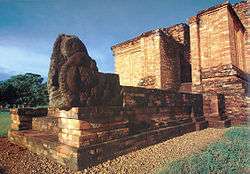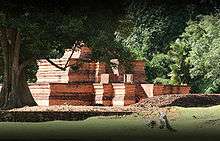Muaro Jambi Temple Compounds
Muaro Jambi (Indonesian: Candi Muaro Jambi) is a Buddhist temple complex, in Muaro Jambi Regency, Jambi province, Sumatra, Indonesia. It is situated 26 kilometers east from the city of Jambi. The temple complex was built by the Melayu Kingdom, with its surviving temples and other archaeological remains estimated to date from the 7th to 13th century CE. The archaeological site includes eight excavated temple sanctuaries and covers about 12 square kilometers, stretches 7.5 kilometers along the Batang Hari River, 80 menapos or mounds of temple ruins, are not yet restored.[1][2] It is one of the largest and best-preserved ancient temple complexes in South East Asia.

It was suggested that Muaro Jambi Temple compound might be the initial location of Srivijaya kingdom. This is mainly because, Muaro Jambi has far richer temple concentration—in contrast to the scarcity of archaeological sites in South Sumatra.[3]
History
The start of the rise of the kingdom of Melayu can be dated to 1025 when India's Chola kingdom attacked and destroyed the capital of the Sumatran maritime empire of Srivijaya. This allowed a number of smaller Sumatran polities to expand their political and economic influence. During the twelfth and thirteenth centuries it seems that from its river estuarine basis along the Batang Hari, Melayu became the dominant economic power in Sumatra. The substantial archaeological remains at Muaro Jambi suggest that this may have been the site of the Melayu capital. The city's age of glory came to an end in 1278 when Java's Singhasari kingdom attacked the city, even succeeding in capturing members of the royal family. The site was rediscovered by Dutch explorers in the nineteenth century. It is now protected as a national monument.
Design and decoration

The temple complex of Candi Muaro Jambi is spread out over a large area along the banks of the Batang Hari River. Eight temple complexes have been excavated but many more mounds and sites remain to be explored within the conservation area, much of which is still covered by thick jungle. The three most significant intact temples are known as Candi Tinggi, Candi Kedaton and Candi Gumpung. The temples are built from red brick and unlike the temples of Java, feature very little ornamentation, carving or statuary. A few pieces of sculpture are housed in a small, on-site museum. The wooden dwellings that are believed to have housed the city's population have all disappeared without a trace. Only 7 temples have been restored, 3 have mentioned above and the others are Candi Tinggi I, Candi Kembarbatu, Candi Gedong I and Candi Gedong II.[2]
See also
References
- "Muaro Jambi Temple: The Legacy of Ancient Jambi". 25 September 2011. Archived from the original on 30 June 2013. Retrieved 3 July 2013.
- Syofiardi Bachyul Jb (25 November 2014). "Muarajambi Temple: Jambi's monumental mystery".
- "Ada Kemungkinan Kerajaan Sriwijaya Berasal dari Jambi Bukan Palembang". Tribun News (in Indonesian). 4 October 2016.
- Oey, Eric M. Sumatra. Periplus Editions (HK) Ltd., 1996.
External links
| Wikimedia Commons has media related to Candi Muaro Jambi. |